Indoor plant scents have a magical effect. With their beautiful fragrances, indoor plants enhance your mood, add a natural aroma to your home, and relax you at the same time. Also, these qualities of fragrance indoor plants energize you and increase your productivity.
In this article, I am going to teach you about amazing fragrance plants that can induce sleep and make you feel relaxed. As well as this, I will discuss many other fragrance plants used in Indian cuisine. Also, there are plants with attractive aesthetics and pleasant scents that can make your home seem more inviting and pleasant.
On this list, I have picked fragrance indoor plants that are popular, easy to take care of, and require little maintenance. Further, they are widely available in India and are easy to buy.
Best indoor plants that bring fragrance to the home
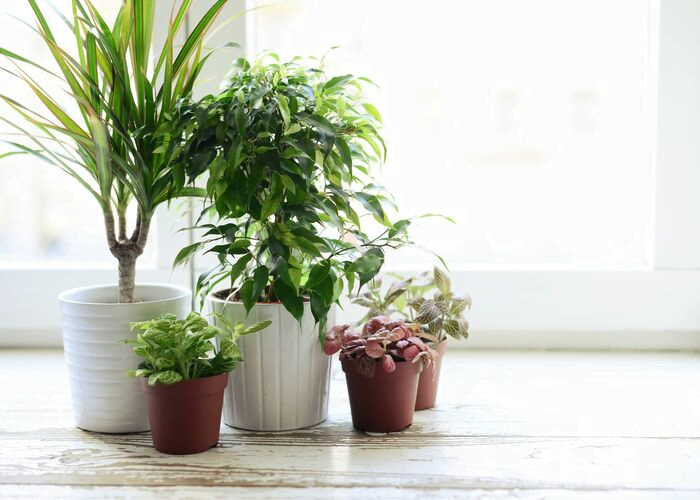
Indoor fragrant plants come in many varieties, some of which have sweet fruity scents, such as gardenias, hedychiums, and jasmines. Alternatively, if you prefer spicy, musky, or citrus fragrances, then Leucospermum or Cymbidium are excellent choices. Besides these fragrances, there are some beautiful looking plants that smell amazing. Let’s take a closer look at each one.
1. Jasmine
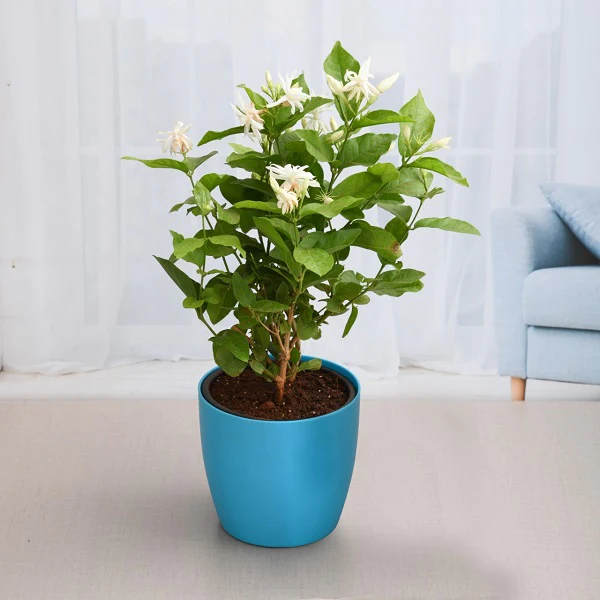
Jasmine plants are not only beautiful but also emit a sweet, relaxing fragrance that can help to create a peaceful and inviting atmosphere in any home.
Buying a Jasmine plant is a simple and affordable way to improve your living space and enhance your overall well-being.
2. Gardenia
If you enjoy subtle scents, then Gardenia is the plant for you.
Their aroma is rich and tropical fruity. The most fragrant time of day for gardenia is at night.
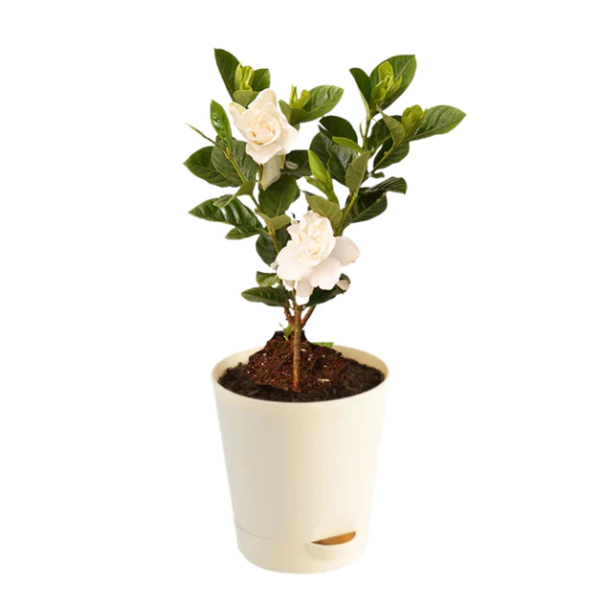
3. Lemon Grass
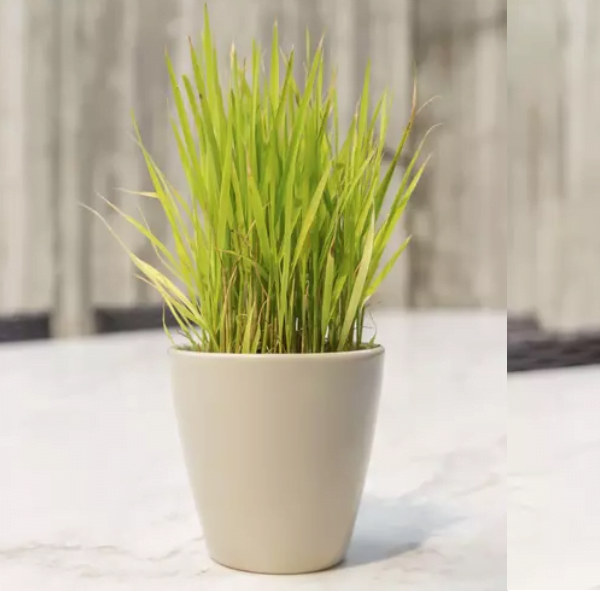
The long, slender gray-green leaves of lemongrass make your home look gorgeous.
Besides having a fresh, lemony scent and flavor, lemongrass is also a great herb for medicinal purposes.
4. Cinnamon
A cinnamon plant is the best option for removing unpleasant odors from your home.
Aromatically, it has a fruity, peppery, vanilla-like, and warm smell.
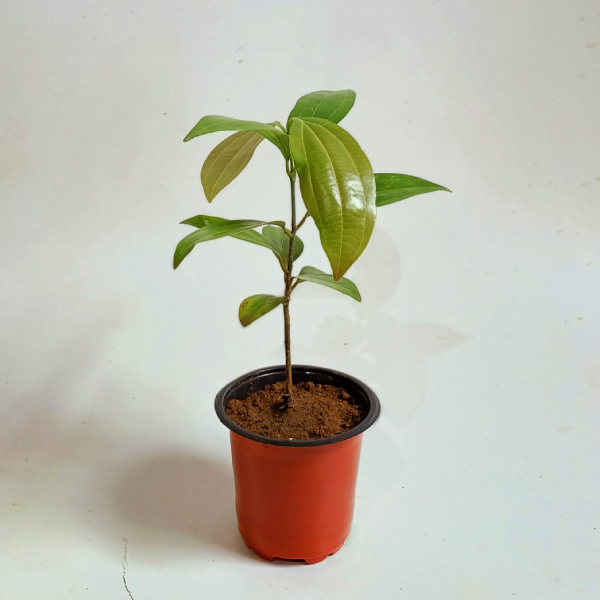
5. Jasmine sambac
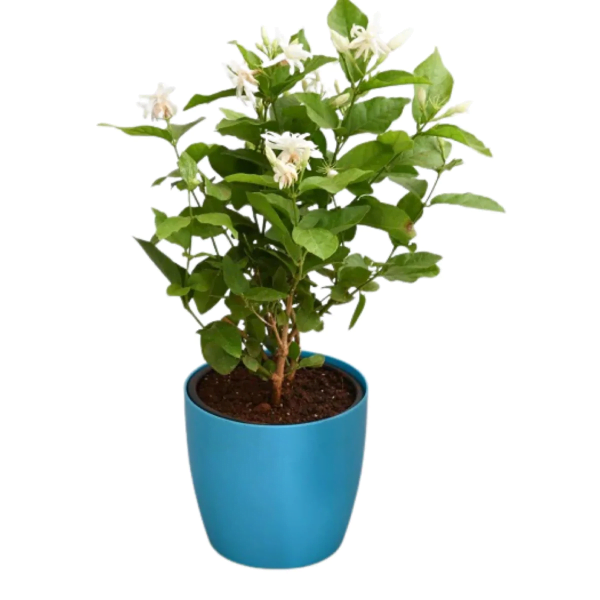
Summer is a wonderful time to enjoy the fragrant blooms of jasmine plants.
There is a rich, floral, honeyed, and sweet scent to it.
The leaves are also used in traditional medicine, aromatherapy, perfumes, and teas.
6. Frangipani
These cute Frangipani flowers are white with yellow centers and five petals.
Its oily scents also make flowers appealing. The long-lasting scent of frangipani makes it a great fragrant indoor plant.
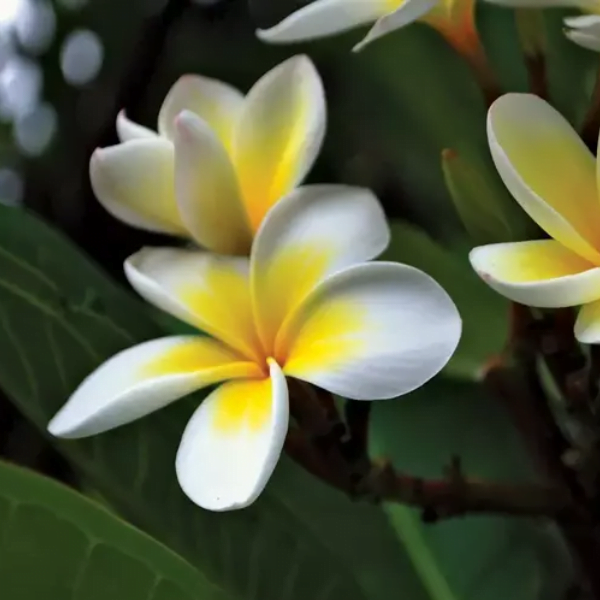
7. Rose
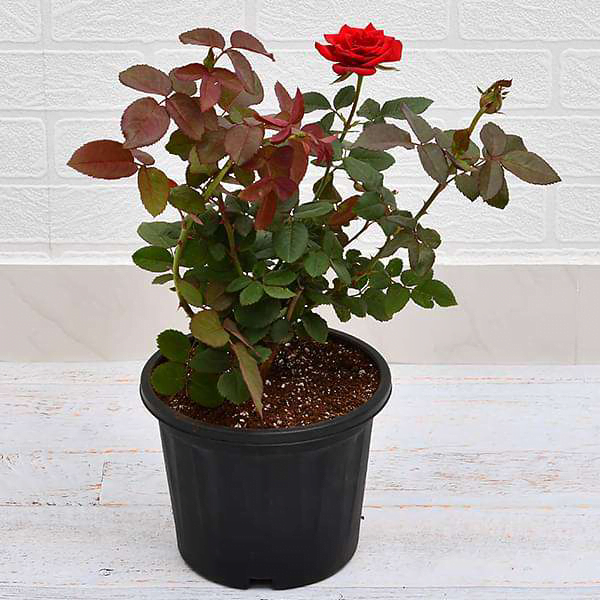
There are a lot of colors to choose from when it comes to roses.
The darker the color, the more fragrant the rose. Plus, you get a stronger smell when your rose has more petals.
More fragrance comes from thicker petals.
8. Jasmine polyanthum
There are beautiful flowers on jasmine polyanthum that resemble stars.
It smells divine, sweet, and heavenly when a room is filled with jasmine flowers.
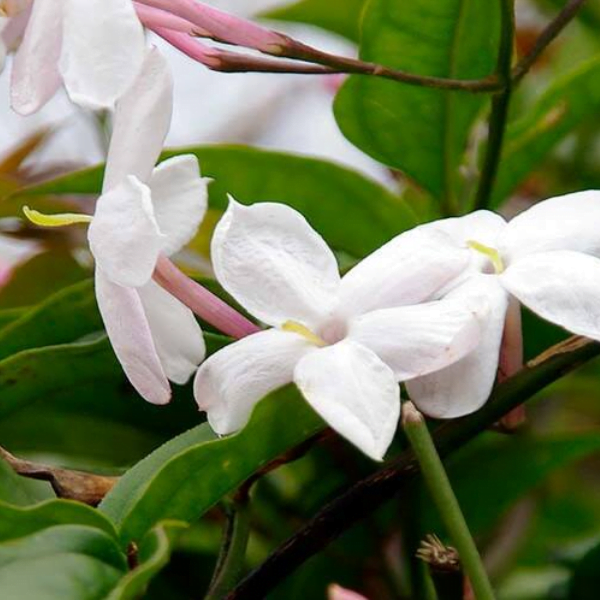
9. Gardenia jasminoides
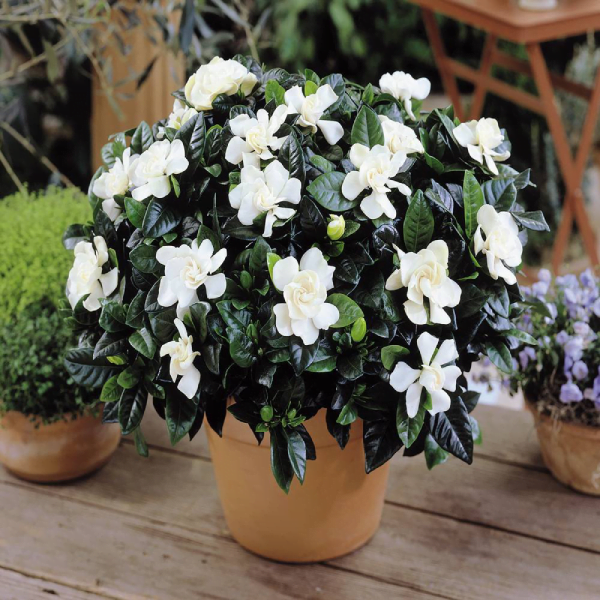
It’s always a pleasure to admire Gardenia jasminoides’ fragrance and white blossom during the summer.
They have a heavenly smell of floral aromas that are slightly sweet and fruity.
10. Hedychium
There is a gingery fruity aroma to this beautiful, fragrant indoor plant.
You almost get tuberose and gardenia smell from it.
Like a butterfly, the petals are also intricately shaped.
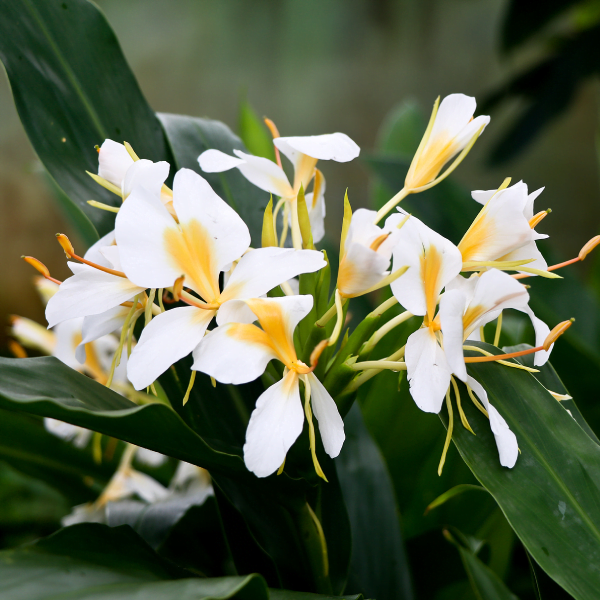
11. Cymbidium
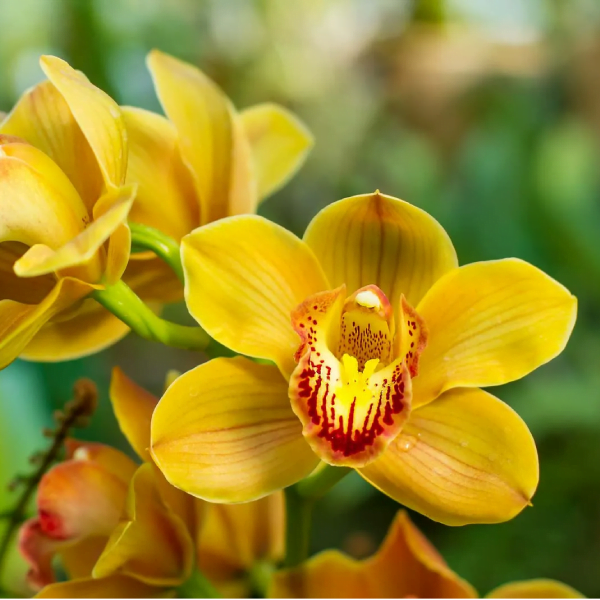
The long leaves and popular flower types make Cymbidium orchids attractive indoor plants.
Similar to lemons, their vibrant yellow color produces a citrus aroma.
It is almost impossible to miss the smell of these orchids.
12. Vanda
The blue flowers of Vanda orchids set them apart from other orchid varieties.
There are scents like cinnamon and vanilla, chocolate and citrus, and imitations of roses.
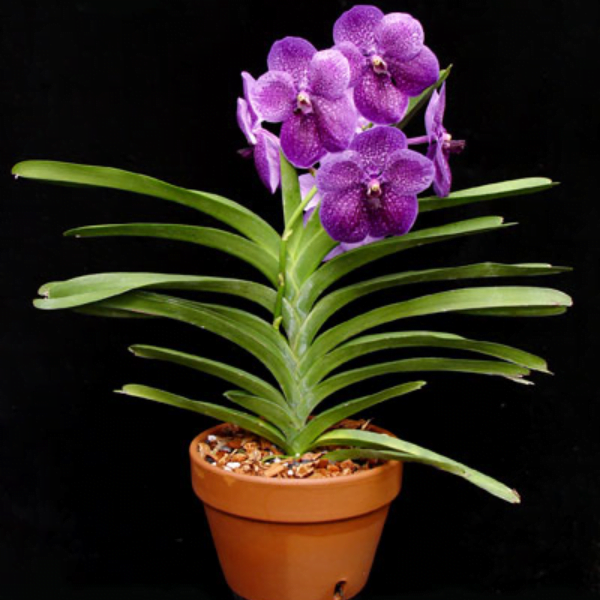
13. Osmanthus
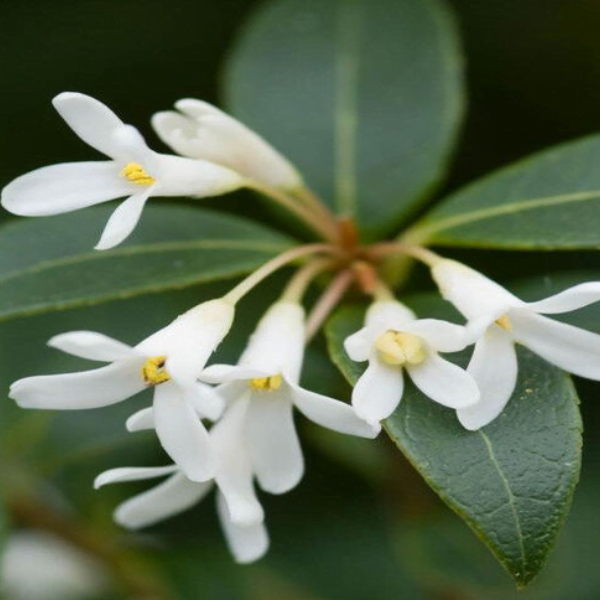
White flowers emit a strong scent from Osmanthus’ leathery, sharp leaves. There’s a slight jasmine scent to osmanthus.
From these indoor fragrant plants, you can smell intense floral and fruity scents for several meters.
14. Leucospermum
In spring and early summer, it blooms in pincushion-shaped clusters, and its leaves are thick, leathery, and evergreen.
These flowers have a nice spicy, musk smell.
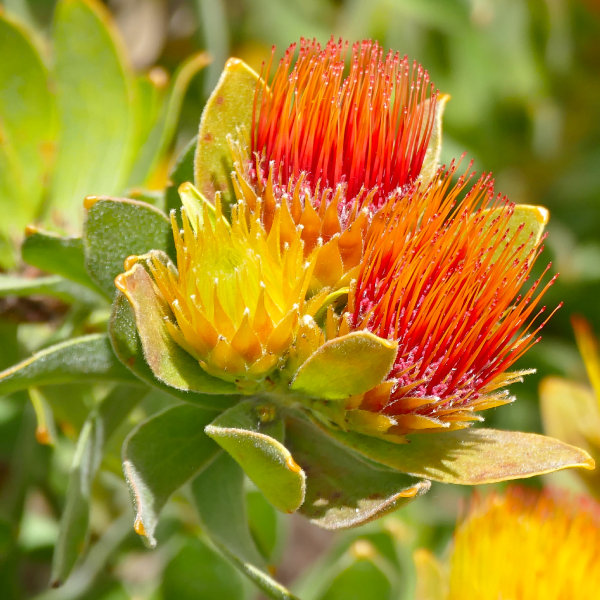
15. Clove
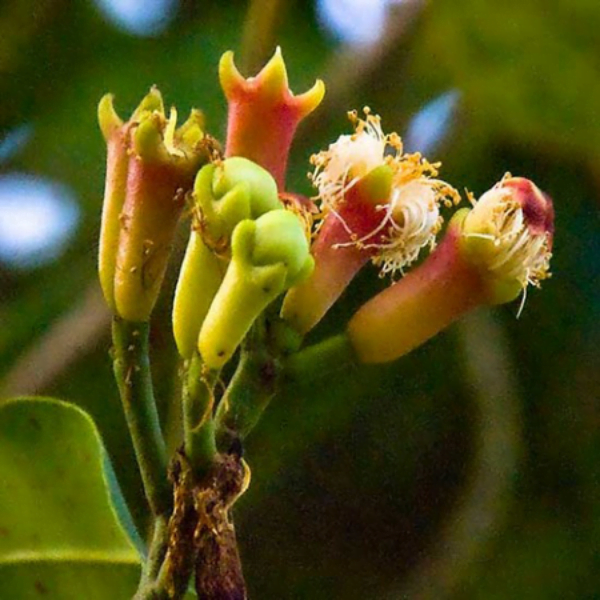
Reddish-brown flower buds and moderately slow growth make this plant easy to grow to 100!
There’s a bitter, sharp taste and a rich, warm smell to it.
Best Fragrant Indoor Plants
1. Jasmine
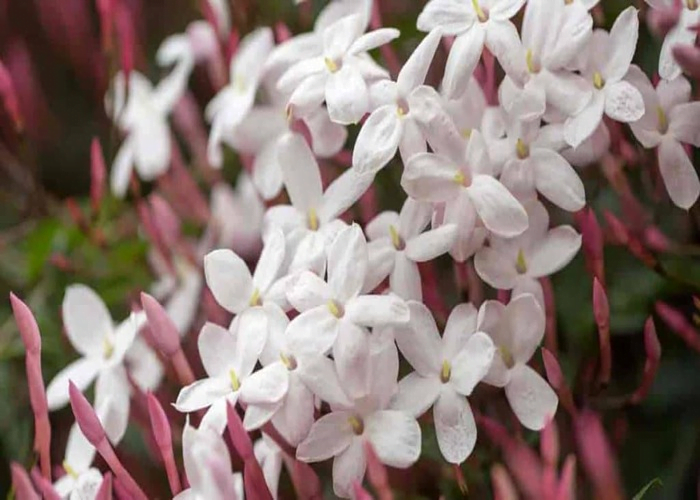
One of the most common fragrant indoor plants in India is jasmine. Its sweet scent makes it a popular choice for weddings, events, and other decorations.
Adding jasmine to your room can fill your space with a heady, lingering scent. Moreover, it is best to enjoy jasmine flowers in the summer or during the rainy season.
When it comes to caring, jasmine is an easy plant to grow. All it needs is plenty of water and a bright corner of your home to thrive. Nevertheless, prune or train the branches after the flowers bloom to prevent them from spreading.
Tips for jasmine:
Pruning jasmine should not be done during or before they are actively blooming, as this can stop blossoming.
2. Gardenia
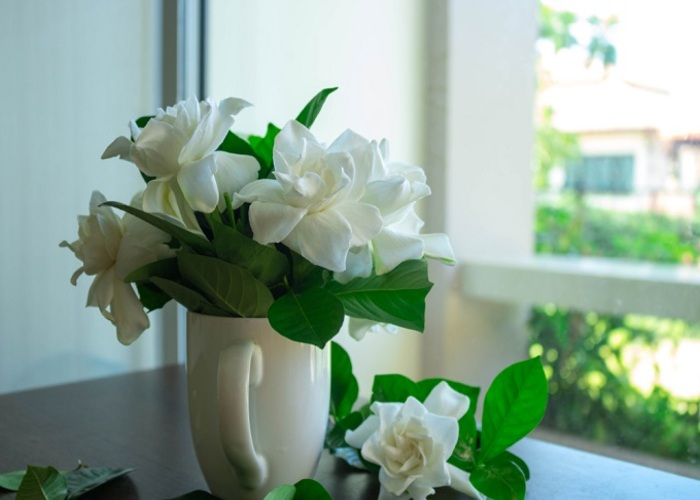
All houseplants smell lovely, but gardenias have perhaps the best scent. There is a tropical fruity and rich aroma to them.
With its lovely, subtle scent, it keeps a home smelling fresh for months. During the night, it is the most fragrant. Furthermore, Gardenia is a major ingredient in many perfumes.
To keep the plant healthy, water it once a week and expose it to bright light regularly.
Tips for gardenia:
Apply a 2-4 inch layer of organic mulch to keep the soil moist and maintain a stable soil temperature.
3. Lemon Grass
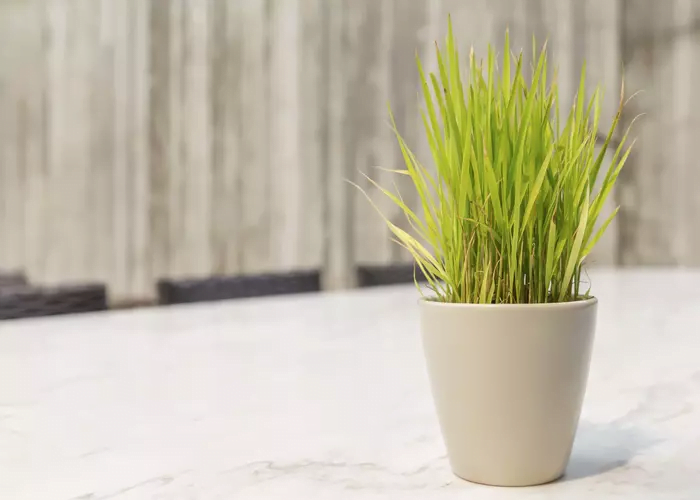
Lemongrass long, slender gray-green foliage adds gorgeous color to your indoor space. A versatile herb, lemongrass has a refreshing, lemony scent and flavor, as well as several medicinal properties.
Also, lemongrass not only adds flavor and health benefits to your diet, but it acts as a natural mosquito repellant. To keep this plant thriving, give it full sun and consistent moisture whenever the top inch becomes dry.
Tips for lemon grass:
Lemongrass plants that survive for more than one season profit from annual pruning to clean up plants and clear dead foliage. The plant will die back for the winter when you should remove the browning leaves only to save it from frost.
4. Cinnamon
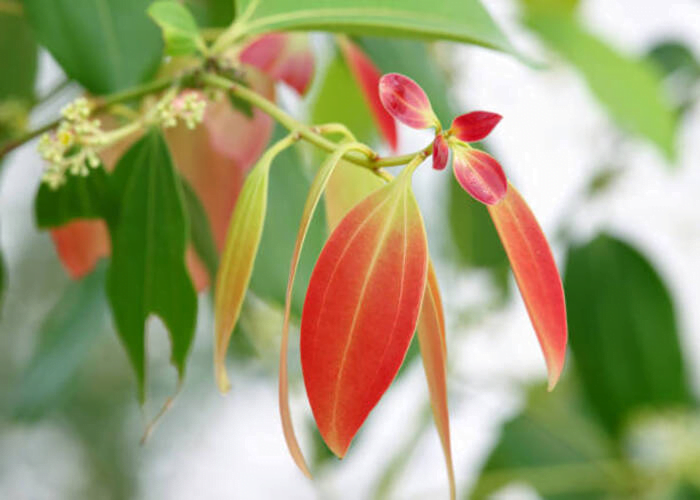
Cinnamon leaves have an elongated, slender, broadly oval shape and are medium in size. Also, a light green vein runs through the center of each leaf of Cinnamon leaf. When fresh, the leaf is leathery and shiny green.
Further, Cinnamon plants are your best option if you have an unpleasant odor in your home. Its fruity, peppery, vanilla-like, and warm aroma is the perfect remedy for unwanted smells.
It grows well in full sun to part shade in medium moisture. Moreover, soils that are moist and well-drained are ideal for cinnamon.
Tips for cinnamon:
Use a well-proportional, time-release fertilizer in the planting hole to get your cinnamon plant started. Then, fertilize every growing season, following label guidelines.
5. Jasmine sambac
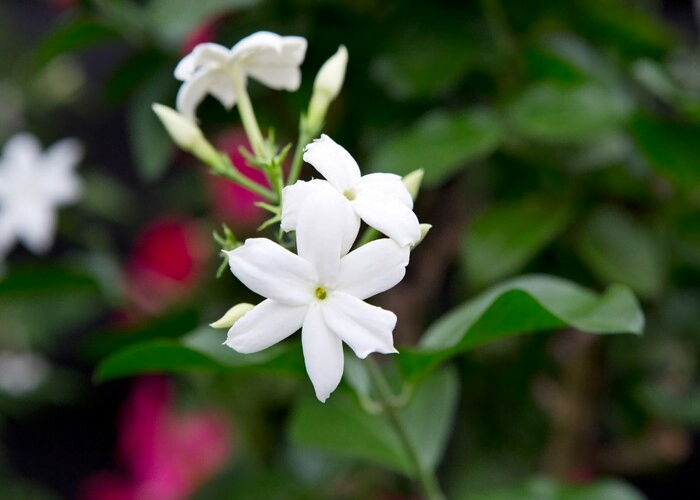
Gardeners and homeowners enjoy the fragrant blooms of Jasmine plants in the summer. It has a rich, floral, honeyed, and sweet scent. Additionally, they are used in traditional medicine, aromatherapy, perfumes, and teas.
Bright indirect light to full sun is best for Jasmine Sambac. However, it isn’t suitable for low-light environments. Between waterings, allow potting mix or soil to dry about halfway down. Moreover, when the light is brighter, you will need to water more frequently.
Tips for Jasmine sambac:
- Jasmine sambac cannot endure waterlogging, and plants will quickly die in the wet soil. Average watering is sufficient for the plant and essential during the flowering season.
- The pH of the soil should not be higher than 6.5 for a good plantation.
6. Frangipani
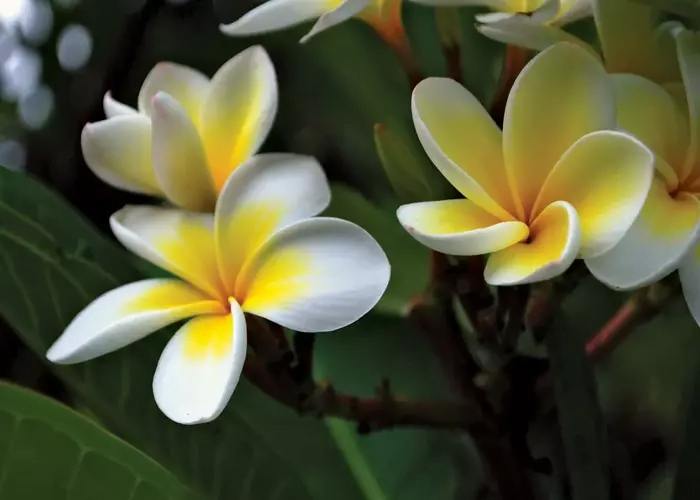
Frangipani plant bloom with white flowers in clusters of three to five at the ends of their stems. Each flower has five petals and is white with yellow centers. Additionally, some people find flowers pleasing due to their oily scent.
Fragrant flowers and long-lasting fragrances make frangipani excellent fragrant indoor plants. Also, due to its low maintenance requirements, this plant makes a perfect houseplant.
For frangipanis to thrive, they need full sun and water regularly during the summer so they don’t dry out.
Tips for frangipani:
Frangipani has a large hunger while growing, so provide fertilizer regularly during this period with a flower-booster fertilizer that’s fairly high in phosphorus and low in nitrogen, with added iron and magnesium.
7. Rose
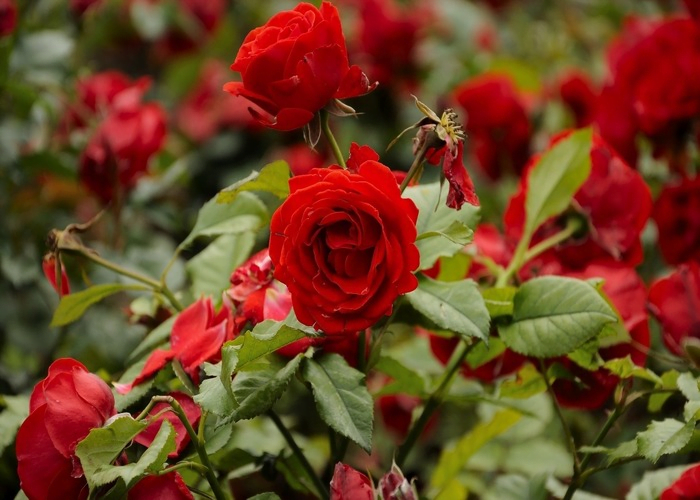
The fragrance of roses is probably one of the best things about them. Roses come in a variety of colors. However, roses that are darker in color are more fragrant. Also, you get a stronger smell when your rose has more petals. The thicker the petals, the more fragrance they contain.
Make sure your roses are planted in a sunny location with good drainage. You can make your flowers look impressive by fertilizing them regularly. Also, ensure that the soil is kept moist by watering them evenly.
Tips for rose:
Dice banana peels and sow them underneath a rose. Dig carefully to avoid troubling roots. Bury peels approximately 4 inches deep.
8. Jasmine polyanthum
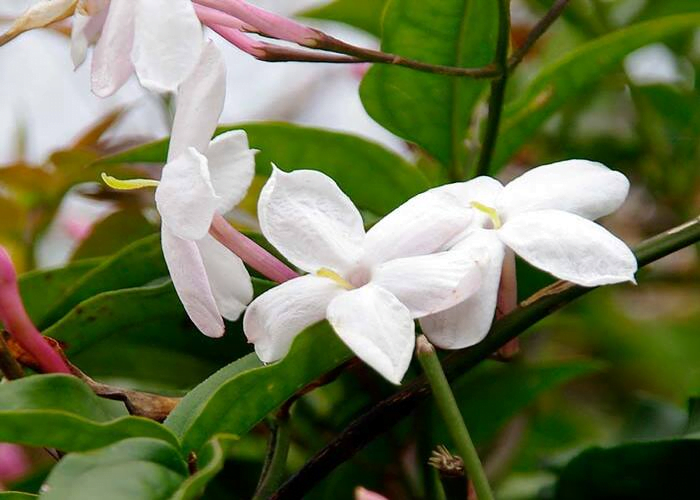
Jasmine polyanthum is an aggressive climber with beautiful flowers that resemble stars. A room filled with jasmine flowers is filled with a glorious, sweet, heady scent.
It is best to grow your jasmine plant in a South-facing window as it requires bright light and some direct sunlight. If a Jasmine is in bloom and in active growth, it requires plenty of water. As long as the soil is moist, the plants will thrive.
Tips for jasmine polyanthum:
- Provide it with a frame to climb and frequent pruning to maintain it neat indoors, or allow it to run unrestricted or clamber up upright structures outdoors.
- Jasmine requires at least a 15-degree Fahrenheit contrast between day and night temperatures to produce flowers.
9. Gardenia jasminoides
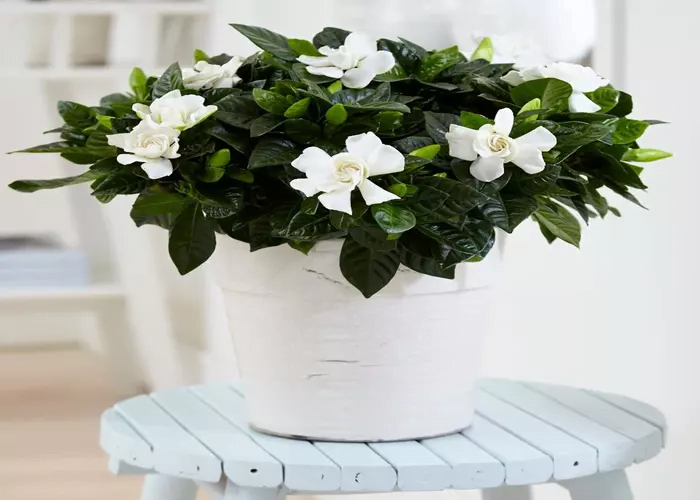
Summer is a beautiful time to enjoy Gardenia jasminoides’ fragrance and white blossoms. A Gardenia or Cape jasmine is an excellent addition to a warm environment. Besides its ornamental value, it is also used for medicinal and culinary purposes.
They require bright light, moderate temperatures, average to high humidity, and well-drained, acidic soil when grown indoors. Make sure you water moderately with room temperature water.
Tips for gardenia jasminoides:
- Delay to prune your plant after the latest flowers have faded. By this method, you won’t prune back any growth on fresh buds that may develop.
- Control “bud drop” by ensuring humidity and water levels are just correct.
10. Hedychium
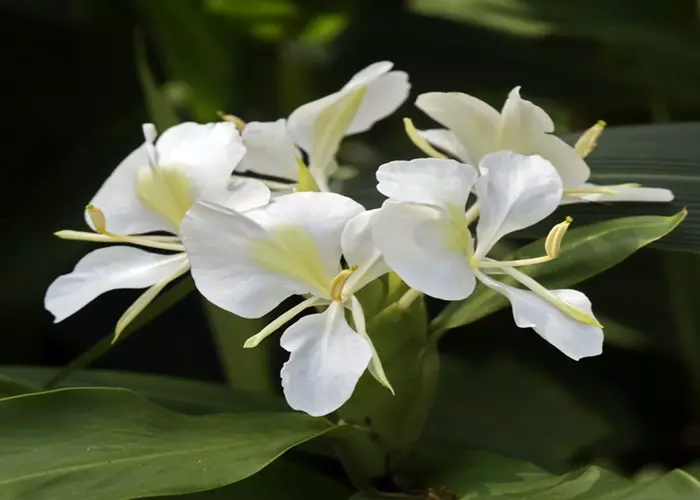
These beautiful fragrant indoor plants have a sweet, tropical aroma with a gingery fruity. It almost smells like tuberose and gardenia.
Also, similar to a butterfly, the petals form an intricate shape. In perfumery, these fragrant indoor plants are used since they have an intensely sweet scent.
In terms of light, these indoor fragrant plants thrive in full sun, but they can tolerate partial shade as well. When it’s hot and dry in the summer, these flowers need medium-to-wet watering. Ensure that the soil doesn’t dry out completely, as this can damage the plant.
Tips for hedychium:
- Spread a thin layer of topsoil to save the Hedychium Coronarium seed if you are sowing outside.
- The fluid in the Hedychium Coronarium leaves is a favorite meal for aphids. Use neem oil to get rid of them.
11. Cymbidium
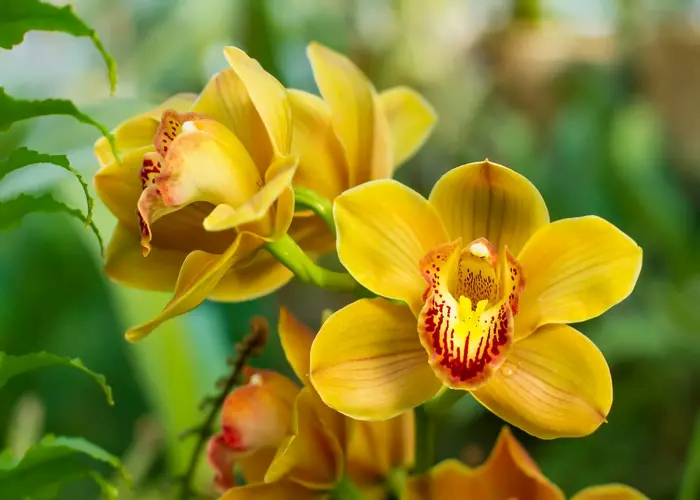
As indoor plants, Cymbidium orchids are attractive because of their popular flower types and long leaves. Their vibrant yellow color gives off a citrus aroma, similar to that of lemons. These orchids have a strong smell that can be detected almost a foot away.
Cymbidiums enjoy the light and can tolerate hotter temperatures. In watering, this one does not like to be dry, so make sure your potting medium stays moist.
Tips for cymbidium:
- Keep at 10–24°C (50–75°F)
- Move outdoors during summer, it will stimulate flowering.
- Grow in bark-based orchid compost.
12. Vanda
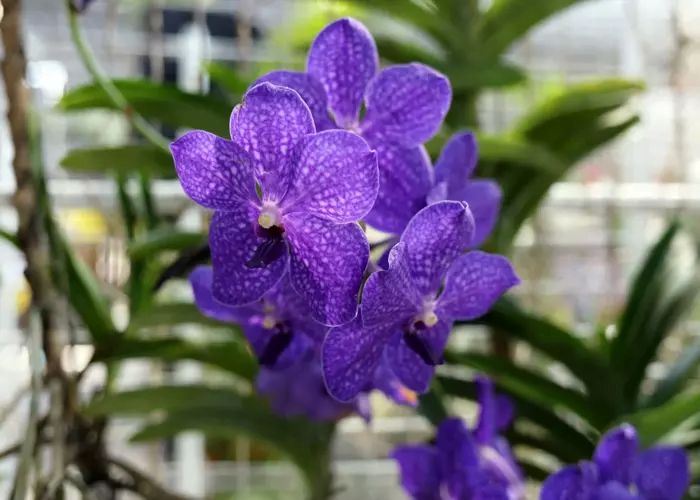
There are many varieties of Vanda orchids, but the blue flowers make them stand out among all others. While they have flat petals, they differ from other orchids with similar appearing blooms because they have rambling roots. There are fragrances like cinnamon and vanilla, chocolate and citrus, and imitations of roses.
The Vanda needs bright light but does not thrive in direct sunlight. There is a great deal of water required by these fragrant indoor plants. Also, during periods of high temperatures, they might need to be watered twice a day. Winter dormancy requires occasional watering.
Tips for vanda orchids:
- Plant a vanda orchid in a hanging basket with a medium that can be without soil for optimal air circulation.
- Maintain humidity levels increased between 70 and 80 percent for a vanda orchid to flourish.
13. Osmanthus
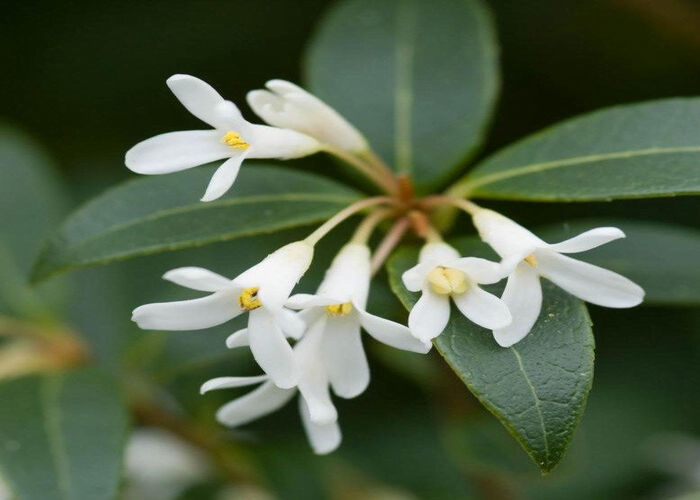
Osmanthus has leathery, sharp leaves and small white flowers with a strong scent. The plant has the aroma of slightly jasmine with hints of a graceful look. An intensely floral and fruity scent extends several meters from these fragrant indoor plants.
It prefers a lot of sunlight, although a little shade will prevent leaf scorch. It thrives in moist, well-drained soil, but will also tolerate dense clay soils. It requires average watering to grow.
Tips for osmanthus:
- Osmanthus will thrive easily in any suitable garden soil, but average, moist, nicely-drained soil is most appropriate. These plants will love acidic to neutral soil (pH 5.0 to 7.5).
- These trees can profit from a single spring fertilization with a slow-release shrub and tree fertilizer, mainly containing sulfur or iron.
14. Leucospermum
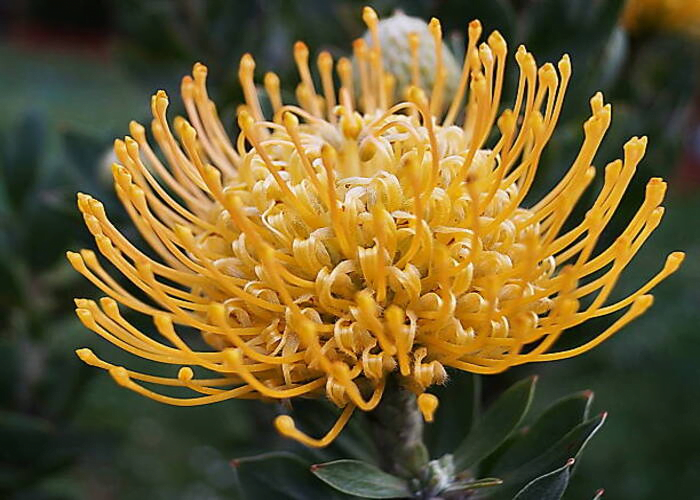
Its beautiful, pincushion-shaped blooms appear in spring and early summer, and its foliage is evergreen, compact, and attractive, with thick, leathery leaves. There is a pleasant spicy, musk scent to the flowers.
You should grow Leucospermum in full sunlight in well-drained, nutrient-poor, acidic soil. Give it a little water and don’t overfeed it.
Tips for Leucospermum:
- They like some room of their own and do not enjoy competing for space.
- Leucospermums thrive on negligence, too much fertilizer and water are not what this species craves. But need protection from frost.
15. Clove
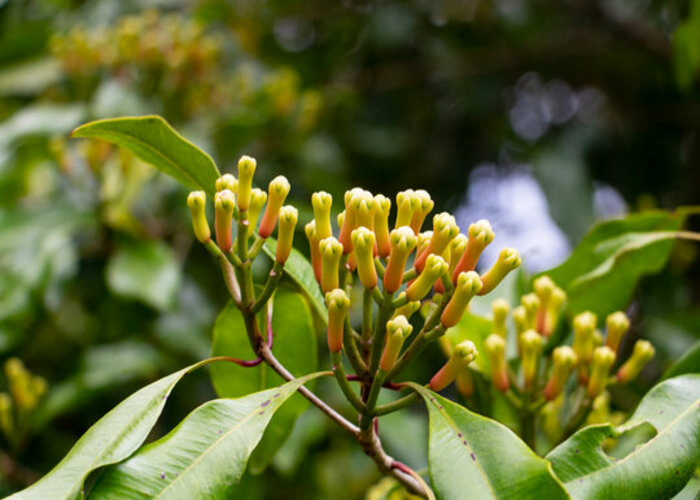
The last fragrant indoor plant we have is clove. This plant has small, reddish-brown flower buds and is moderately slow-growing, it can easily live to its 100th birthday or beyond. Its taste is bitter and sharp, and its smell is rich and warm.
The clove tree grows best in full sun to partial shade. If your soil has good drainage, it will thrive in rich, loamy soil (preferably rich in organic). In the first three to four years of growth, clove trees need the most water.
Tips for Clove Tree:
- Trees in their young stage prefer to receive more shade than the sun.
- A steady temperatures exceeding 50 degrees Fahrenheit are necessary with ideal temperatures standing in the range of 70 to 85 degrees Fahrenheit.
FAQs
Q1. Which flower has the most fragrance?
Ans. Jasmine is the most fragrant flower you can grow indoors. In addition, there are a number of popular varieties of jasmine, such as Jai, Jui, Bela, Mogra, Chameli, etc.
Q2. Which plant gives fragrance at night?
Ans. At night, gardenia and jasmine plants emit the most fragrance.
Q3. Which plant has the strongest fragrance in India?
Ans. Tuberose, Roses, Jasmine, and Raat ki rani has the strongest fragrance in India.
Q4. Which plant smells all year round?
Ans. Osmanthus and lavender plants have a pleasant scent all year round.
Conclusion
The most common reason for bringing indoor plants into a home is to enhance its aesthetic appeal. However, with the mentioned fragrant indoor plants, you can have beauty and a mesmerizing smell at home. With fragrant indoor plants, you will get a wide range of scents, from sweet fruit to warm rich ones.
If you want to keep the amazing scent of blooms thriving, make sure you provide it with the right amount of light and water, as well as keep its soil moist. It is also important not to overfeed any plant. These plants can either be purchased at a local nursery or online through a gardening website. Bring a natural aroma into your home today with these fragrant indoor plants and enjoy the beautiful fragrance they emit. The positive effects they have on your mood, mental health, and productivity are undeniable.
Related Articles
- 15 Best Plants for Front Door Entrance India | Auspicious plants for front door
- 10+ Money plant Benefits That Will Make you Keep It In Your House
- Are Spider Plants Toxic to Cats?- 4 Ways To Prevent Your Cats From Eating Spider Plants.
- Best Plants for the House – 8 Top Apartment Plants That You Can’t Miss
- How to Braid Your Snake Plant: Tips and Care Guide
- 20+ Rare and Unusual Peace Lily Varieties You’ll Love

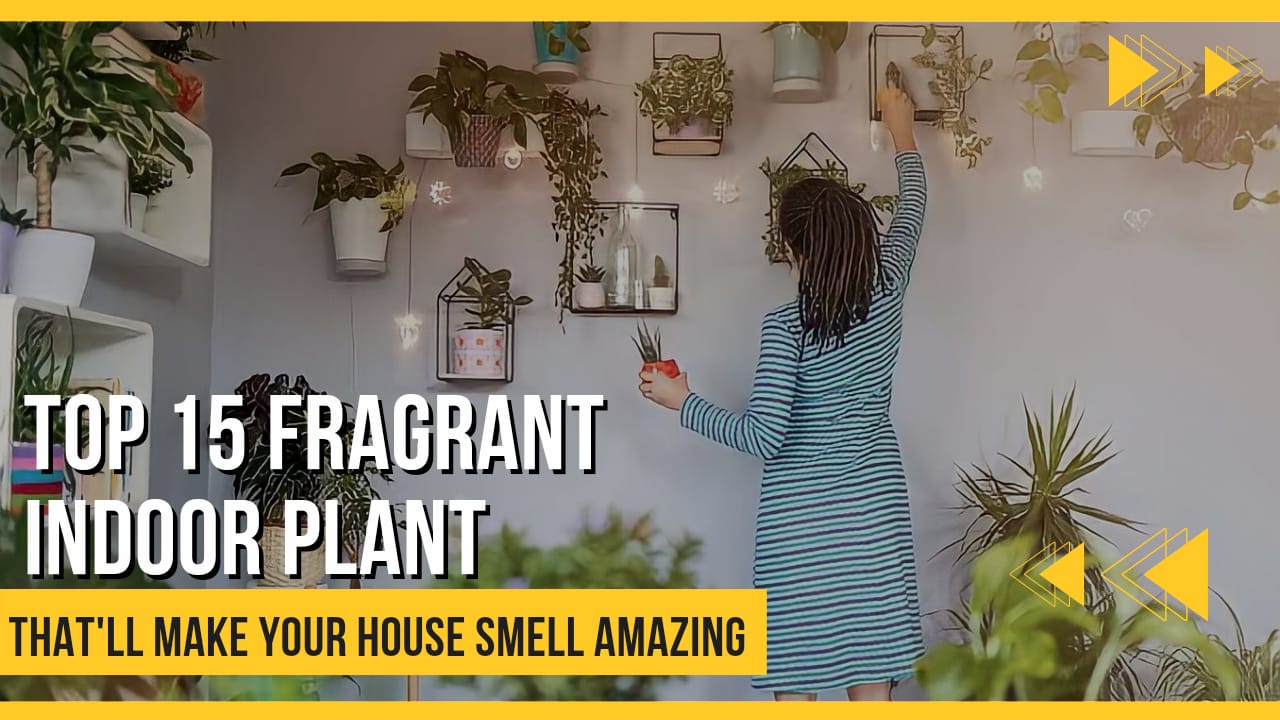


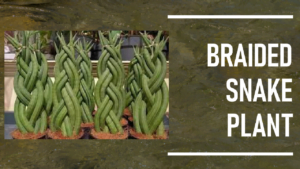
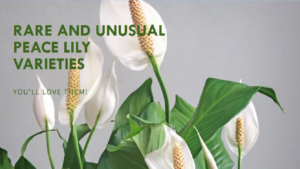
Beautiful flowers